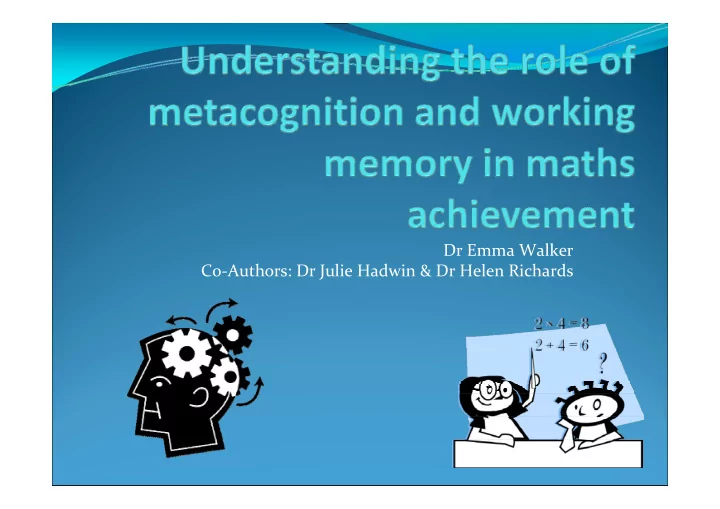

Dr Emma Walker Co ‐ Authors: Dr Julie Hadwin & Dr Helen Richards
Background � Global economic crisis has led to a rise in unemployment, especially in the youth job market � Wolf report on vocational education (2011) ‐ formal maths qualification used as sifting criteria for course places and jobs � Every Child A Chance (2009) – maths qualification increases earning potential � DFE (2010) Low achievement in maths in primary school persists until end of secondary school
Theoretical model Butterworth, Varma and Laurillard (2011) � Model suggests the influence of learning experiences on: � Biological factors: brain areas related to maths � Cognitive factors: memory and some metacognitive processes � Behavioural: performance on maths tasks Demetriou, Christou, Spandoudis and Platsidou (2002) � Model more specifically highlighted the role of metacognition in problem solving � Proposed that working memory provides the ‘cognitive space’ for the execution of metacognitive processes
Definitions � Working Memory = a limited storage control system that coordinates verbal and visuospatial material and manages the transfer of information in and out of long term memory (LTM) (Baddeley & Hitch, 1974). � Metacognition = Monitoring the application of cognitive strategies (Flavell, 1979) 1. Metacognitive knowledge 2. Regulation of cognition
Maths and Working Memory training/Metacognition interventions Working Memory Training � Working memory training studies show improved maths achievement (e.g. Alloway, 2012; Holmes et al., 2009) � Very new research area Metacognition Interventions � Metacognition trained in the context of a maths lesson � Research shows improvements in maths achievement (Kramarski & Mizrachi, 2006; Verschaffel et al., 2009)
Anxiety � Maths anxiety is proposed to affect performance on maths tasks (Ashcraft & Kirk, 2001) � Anxious thoughts (worries) occupy cognitive ‘space’, thus lowering WM capacity (Eysenck & Calvo, 1992) leaving less ‘space’ to process maths information. � Anxiety can impair MC because if an individual has a high level of maths anxiety they are unable to use their MC knowledge when completing a maths task and thus perform poorly (Veenman, Kerseboom & Imthorn, 2000)
Aims and hypotheses • Novel contribution: To measure both Working Memory and Metacognition in interventions focused on achieving change in maths achievement. • Explored intervention’s effect on anxiety and whether this was linked to maths achievement. • Objective was to inform future maths interventions • Following previous research, it was anticipated that pupils in both groups would improve their maths scores but that this would be achieved via change in different underlying mechanisms. • If interventions increased participants’ maths achievement this should be associated with decrease in maths anxiety.
Method Participants � 13 ‐ 14 years old � Underachieving in maths Measures � Wide Ranging Achievement Test (4) – maths subtest (Wilkinson & Robertson, 2006) � Automated Working Memory Assessment (Alloway, 2007) � Junior Metacognitive Awareness Inventory (Sperling, Howard, Miller & Murphy, 2002). � Abbreviated Maths Anxiety Questionnaire Hopko, Mahadevan, Bare & Hunt, 2003). � Spence Children’s Anxiety Scale (Generalised Anxiety items) (Spence, 1998)
Method Procedure � Pre ‐ test in July 2012 � Matched pairs based on T1 maths scores – then randomised to intervention � CogMed and One to One tutoring delivered to two cohorts � Post test � Follow ‐ up 8 weeks later
Analysis � An independent samples t ‐ test on all T1 data indicated no significant differences between scores on any measure with all ts <1.5 and all ps > .1. � In addition to considering statistical significance Effect Sizes (ES) as measured by Partial Eta Squared were reported as small (>.01), medium (>.06) and large (>.14) (Richardson, 2011) � Individual reliable change measures (Jacobson & Truax, 1991)
Results: Maths
Results: Working Memory
Results: Anxiety
Understanding change: The link of maths and anxiety
Discussion CogMed and One to One tutoring Significant improvements in: � Maths achievement � Working memory Significant reduction in : � Anxiety No significant change in: � Metacognition Maths Improvement in CogMed � Consistent with previous research (e.g. Holmes et al, 2009) � No direct link found between maths achievement and working memory Maths Improvement in One to One tutoring � Self ‐ regulation ‐ motivation (Eshel & Kovi, 2007; Luo et al., 2011) � Teacher focus (Chui, 2004). Anxiety reduction and improved maths scores � Cognitive capacity no longer occupied by anxious thoughts (Eysenck & Calvo, 1992; Eysenck et al., 2007)
Limitations � Small sample size � Lack of blinding � No passive control group (the two experimental groups were effectively active controls for each other) � Metacognition measure not sensitive enough or perhaps needed to be domain (maths) specific
Implications � Demonstrated efficacy of interventions studied � Empirical support for use of One to One tutoring Future research • Investigate the impact of factors such as self ‐ efficacy and motivation • Develop understanding of how anxiety is reduced Future interventions � Combine Working Memory and One to One tutoring to maximise improvements
Acknowledgements � Secondary school staff and pupils at the participating school. � Support from CogMed to use the training programme for the research project.
Recommend
More recommend